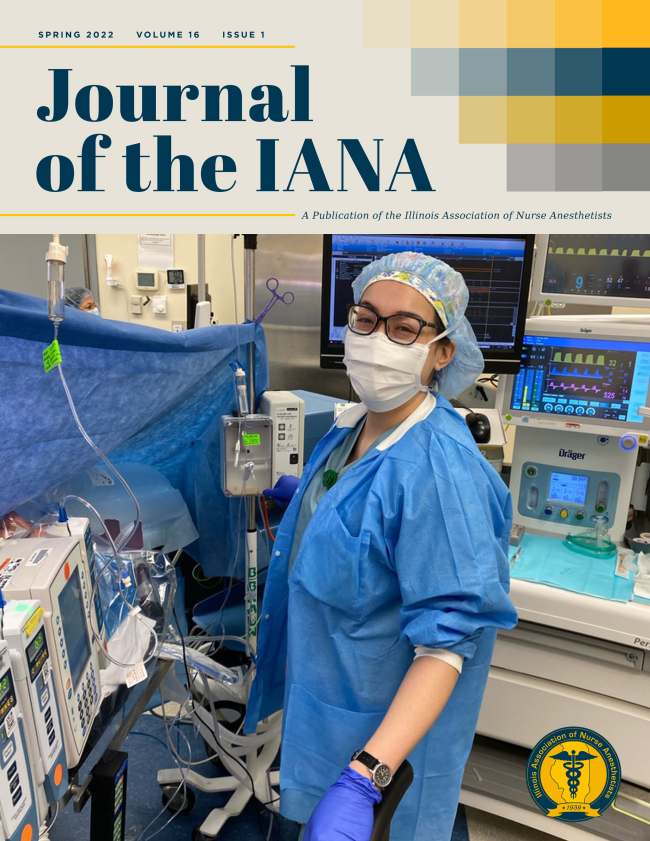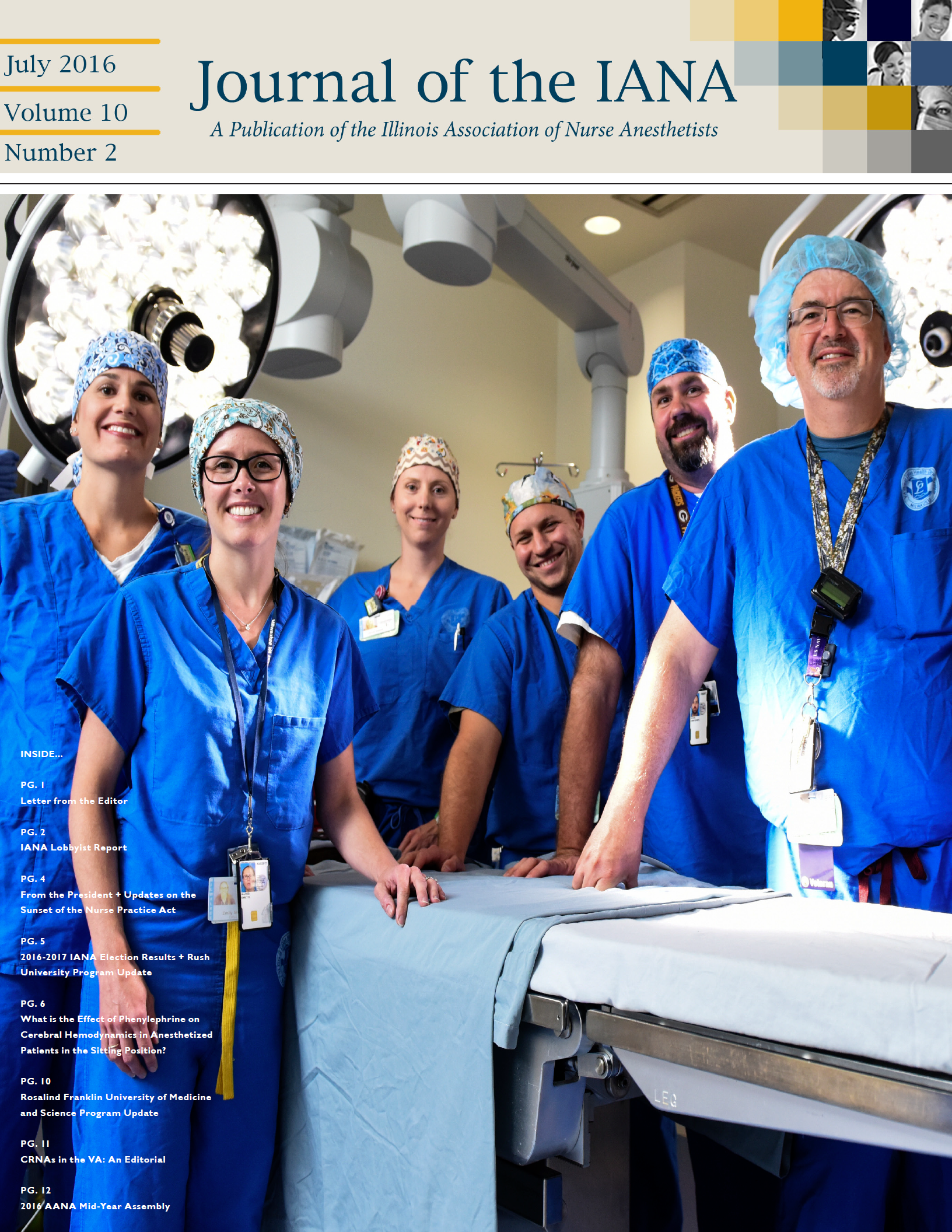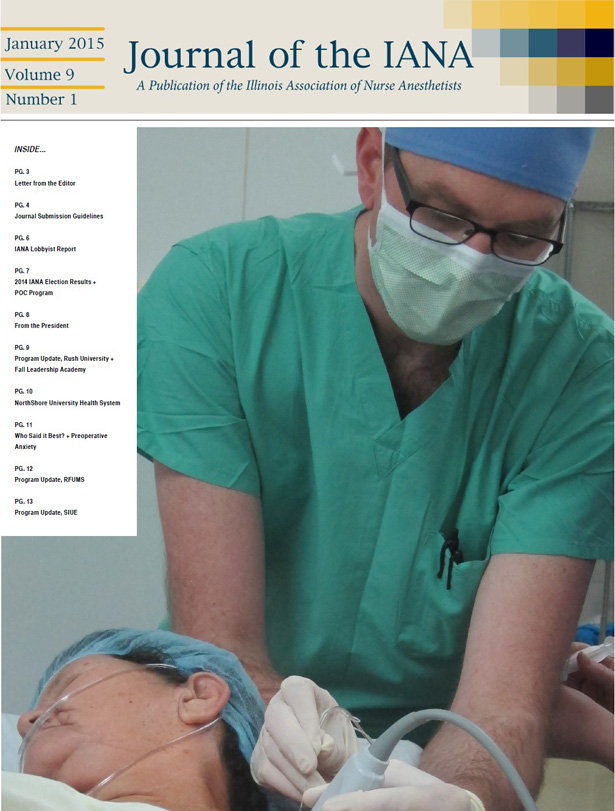Journal of the IANA
Editor: Jeff Matson, CRNA, PhD
The Journal of the Illinois Association of Nurse Anesthetists is a new publication by the IANA. We are excited to bring our members an updated publication that is educational, interesting and timely. Our focus is on the activities of practicing CRNAs in Illinois, news regarding practice issues, and emerging research. To that end, we are taking our research endeavors seriously on our journey to becoming a highly regarded peer-reviewed journal. We have put together a review staff for research submissions, and guidelines for publication of research with the Journal of the IANA. This Journal should be your outlet for research conducted in your facility and university. We look forward to hearing from you.
Submission Guidelines Provided Below
To view previous issues of the Journal of the IANA, please click the thumbnail images below.
2024

2023
2022
2021
2020
2019
2018
2017
2016
2015
To submit a manuscript to the Journal of the IANA, please email [email protected].
Submission Guidelines for Authors
The Journal of the IANA welcomes original manuscripts that are not under consideration by another journal. The article subjects must be pertinent to the specialty of anesthesia and those that relate to the broad professional domain of a nurse anesthetist. Manuscripts published in the Journal of the IANA will become the sole property of the Illinois Association of Nurse Anesthetists. All manuscripts should be submitted to the Editorial Manager at [email protected]. Manuscripts must be submitted using AMA Style.
Please find the submission guidelines for Journal submissions below. If you have questions, please contact IANA at 217.528.6221.
Peer Review
Submitted articles undergo blind review by at least two reviewers. If accepted for publication, the manuscript will be copyedited to improve presentation without altering the meaning of the text. Authors are responsible for all statements made in their work including changes made by the copy editor.
Permissions
When employing material previously published, written permission from the original author and publisher is required. Additionally, written permission is required for use of photographs of identifiable individuals.
Conflict of Interest
Authors must disclose commercial associations that might pose a conflict of interest in connection with submitted work. All authors must disclose any financial and personal relationship with other people or organizations that could influence their work. Each author will be required to sign a conflict of interest statement. Additionally, all funding sources or grant agencies that supported the work must be identified. All disclosures will be noted on the published article.
Manuscript Preparation
To avoid delays in the review process, manuscripts should be carefully prepared according to these guidelines and proofread thoroughly for errors in grammar and spelling. The manuscript should be read for clarity and accuracy by colleagues and/or mentors before submission to the Journal of the IANA. Manuscripts should be set in 12-point type and not exceed 2,000 words including title, references, figures, and tables. Number the pages from the first page of the text to the end of the references. Authors are invited to submit articles in the following categories and formats described below:
- Original Research – A report of an original investigation. The article should include a title page, abstract (200 words maximum), 3 to 5 keywords, text (subdivided into Introduction, Materials and Methods, Results, and Discussion), and references. Quantitative studies should also include a power analysis. If applicable, figures (with legends) and tables should be provided. Manuscripts describing investigations carried out in humans or animals must include a statement indicating that the study was approved by the authors’ institutional investigation committee and that written permission was obtained from human subjects. Also submit a copy of the IRB approval letter.
- Survey/Review – Assimilates, describes, and critically evaluates previously published material to aid in evaluating new concepts. The article should include a title page, abstract (200 words maximum), 3 to 5 keywords, text (subdivided into Introduction, History and Review of Literature, Discussion of State of the Art, and Summary), and references. If applicable, figures (with legends) and tables should be provided.
- Case Report – A report of a clinical case that is uncommon or of exceptional educational value that may be encountered in clinical practice. This category may constitute a brief description of a clinical episode or an in-depth case presentation. The authors must have been personally involved in the case. The article should include a title page, abstract (200 words maximum), 3 to 5 keywords, text (subdivided into Introduction, Case Summary, and Discussion), and references. If applicable, figures (with legends) and tables should be provided.
- Policy Feature - identify issues, trends, barriers, legislative successes, or recommendations that affect nurse anesthetists’ ability to practice. The article should include a title page, abstract (200 words maximum), 3 to 5 keywords, text (subdivided into Introduction, Review of Literature, Discussion of the political findings, and Summary), and references.
- Letters to the Editor – Include brief constructive comments concerning previously published articles or brief notations of general interest. Length should not exceed 350 words.
- Abstracts – A summary of scholarly work that has been published or accepted for publication in another journal that has specific impact for the nurse anesthesia community practicing in Illinois. The submission should include a title page, text limited to 350 words, and references. Must include written permission of first author.
- Student Papers - Students are held to the same standards as other authors, and their papers must be written in a scholarly format at the level for experienced CRNA readers. Student papers must meet the requirements of the journal and be co-authored by a university faculty member who has worked with the student to ensure the paper is in publishable form. Studies must include a methodology with large enough sample size to result in valid conclusions that can be generalized beyond the sample itself. If accepted, student papers will be held for publication until the students have graduated.
References
A maximum of 50 references (only those sources cited in the text) are allowed. Cite references in the numerical order that they appear in the text. References cited in the article should be of previously published articles or texts. Cite written or oral personal communications in parentheses in the text. Carefully validate all references to ensure that they are cited accurately, completely, and in the style indicated above. Cite up to 6 authors. If there are more than 6, cite the first 3 only and add “et al.” Consult AMA Manual of Style, 10th edition, for complete rules on references. Here are a few examples:
Journal
Schwartz A, Bosch LM. Anesthetic implications of postpolio syndrome: new concerns for an old disease. AANA J. 2012;80(5):356-361.
Book Chapter
Tunajek SK. Standards of care in anesthesia practice. In: Foster SD, Faut Callahan M, eds. A Professional Study and Resource Guide for the CRNA. 2nd ed. Park Ridge, IL: American Association of Nurse Anesthetists; 2011:149-174.
Website
US Department of Veterans Affairs. National Center for PTSD Website. PTSD Overview. http://www.ptsd.va.gov/public/pages/fslist- PTSD-overview.asp. Accessed September 17, 2012.
Internet references should be kept to a minimum, and those cited must be from established, peer-reviewed sources with stable archived information. In rare instances when non–peer-reviewed Internet sources need to be referenced, websites of long-standing, national stature, such as the Malignant Hyperthermia Association of the United States or the National Patient Safety Foundation, may be appropriate.
Required Format
- Title Page – Submitted as a separate file. Include manuscript title, authors’ names and credentials, professional position, current employer, city, and state. Provide a correspondence address, email address, telephone number, and an acknowledgment section, if needed. Author identification should appear only on the title page of the manuscript.
- Author Information – A short biographical sketch of each coauthor, with principal author indicated, must accompany the title page of the manuscript. Please include an email address that can be published for the principal author.
- Keywords – Provide 3 to 5 keywords.
- Abstract – The abstract (maximum of 200 words) will appear as the italicized portion preceding the main text. The abstract of the article should include a brief description of the purpose, hypothesis, or theoretical background of the article, followed by 2 to 3 sentences describing the method of the study or the nature of the review. For a research article, include how the data were analyzed. Continue with 2 to 3 sentences devoted to the major points or results noted in the article. Finally, provide a conclusion or take-home message. An abstract of a case report should provide a summary of the case and a discussion. When abstracting a review article, provide a concise summary of the salient points addressed in the review.
- Figure Legends – A legend should be provided for each figure.
- Figures – Clearly reproducible photographs, diagrams, and graphs should be labeled as “Figure 1,” “Figure 2,” etc., depending on their sequence in the manuscript, and on separate pages. Resolution of digital photographs must be at least 300 pixels per inch.
- Tables– Tables should be double-spaced and submitted separately from figures. Tables should be numbered as “Table 1,” “Table 2,” etc., depending on their sequence in the manuscript, on separate pages, and descriptively titled.
Checklist
1. Cover letter of submission.
2. Title page, includes article title, author name(s), credentials, affiliations, short biographical information, telephone number, email address, grant support, and acknowledgments (optional).
3. Three to 5 keywords or phrases.
4. Abstract (maximum of 200 words).
5. Text, double-spaced throughout.
6. References (maximum of 50, double-spaced).
7. Good quality, reproducible figures.
8. Tables, figures, and legends, properly labeled.
9. Permission to reproduce previously published material or photographs of identifiable individuals for printed and electronic versions.
10. Copy of institutional investigation committee/review board approval (for research articles).
11. Conflict of Interest Statement.
|














